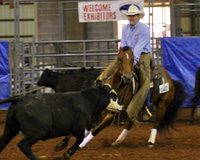
If you’ve ever attempted to sit the trot on a bouncy equine, you already know how jarring it can be for a rider. But what about for the horse, enduring a rider jostling around on his back? A new study suggests that a sitting trot could put more stress on a horse’s back and increase the risk of equine back injury than the posting (rising) trot.
Posting at the trot serves to control the energy of the trot. By engaging their legs and core muscles to rise slightly above the saddle with each stride of the trot, the riders control their body weight to rise and fall in rhythm with the horse rather than allowing it to bounce on the horse in full force.
Dressage riders sit the trot at first level and above, so the study may merit further research for that sport. Western riders, who also do not typically post at the trot, will note that dressage horses have a much loftier gait than the shuffling jog of a western pleasure horse. This particular study did not examine the differences in various types of horses or equestrian sports.
While posting puts less stress on a horse’s back, it is not the least stressful style of riding. By building a simulated horse-and-rider model, de Cocq found that riding in the position used by jockeys, elevated above the saddle and interfering with the horse as little as possible, was the least stressful for the horse. Of course, the perched position wouldn’t fit with non-racing sports where riders use their seat and leg aids to cue their mounts. Furthermore, the study notes that the position used by jockeys takes a tremendous amount of strength on the part of the rider.
Further Reading
Horsemanship How-to: Post the Trot
Perfecting the Posting Trot






That is a good thing to know. I will have to practice posting more.
Ok, any good rider could tell you that obviously it hurts the horse when you don’t post! LA. DUH.
Legit, who wants a person on your back bouncing all over tarnation!?!?!? My friends horse will buck if you don’t post to his trot! Great article though.
Well, it certainly makes sense. Probably better for the rider’s back too!
I always had to post even though I ride western cause I learned to ride on a Standardbred/QH with a horrible trot.
Riding a young haflinger that is still developing is like sitting in an old truck on its last legs. It is difficult to ride a young draft because they are not built for flashiness, they are built for power. I love riding my haffies canter though, it smooth and rocking chair like.
It makes sense that a posting trot would interfere less with a horse’s movement. Good article, thanks!
makes sense bouncing on spine wouldn’t feel that great